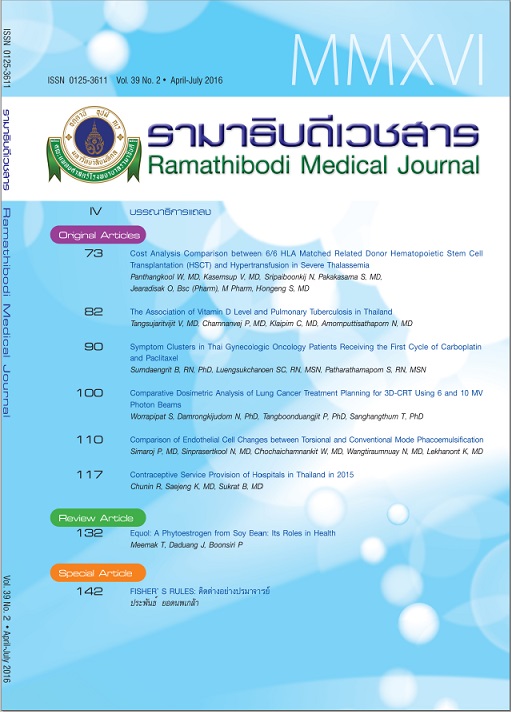The Association of Vitamin D Level and Pulmonary Tuberculosis in Thailand
Main Article Content
Abstract
Background: About ten million of the world population has vitamin D deficiency The associations between vitamin D deficiency and tuberculosis (TB) may be explained by evidence for an immunoregulatory role of the vitamin. A previous study has shown that polymorphisms in vitamin D receptor associated with TB infection in some population and in some studies showed the association of vitamin D deficiency with pulmonary TB as the risk factor. In Thailand, there has been no prior study about the association between vitamin D deficiency and TB patients.
Method: Serum 25-hydroxycholecalciferol concentrations were measured who clinical history and laboratory suggesting of active pulmonary tuberculosis. We measured serum calcium, phosphate, creatinine, liver function test and recorded the symptoms. Demographic data such as chest X-ray finding, body weight and height were collected. Age, sex matched control population who were not diagnosed having pulmonary TB, did not have symptom suggesting TB and had normal chest X-ray was measured for serum 25-hydroxycholecalciferol concentrations. We exclude those who had chronic kidney disease, nephrotic syndrome, liver cirrhosis and who use antiretroviral, steroid, antiepileptic drug and supplementary nutrition which influence the vitamin D level.
Result: We collected 30 patients in TB group and 31 in healthy adult control group. The characteristic between groups is not different. We observed vitamin D below 40 ng per milliliter in 90% (27/30) of the TB patients and 100% of the healthy control group and there is no statistical significance between these two groups.
Discussion: There is no statistical significant of the different between mean serum 25-hydroxycholecalciferol in patient with pulmonary TB and control group. As compared with previous studies, the number of patient with pulmonary tuberculosis who had vitamin D deficiency in this study was higher than in the previous studies. The previous studies showed that vitamin D deficiency is associated with higher risk of active tuberculosis, but our study did not show this association.
Article Details
References
Holick MF. Vitamin D deficiency. N Engl J Med. 2007;357:266-81.
Wiwanitkit V. Prevalence rate of active tuberculosis from chest radiography among Thai hospital personnel: a summary. Am J Infect Control. 2005;33:313-4.
Rook GA, Taverne J, Leveton C, Steele J. The role of gamma-interferon, vitamin D3 metabolites and tumor necrosis factor in the pathogenesis of tuberculosis. Immunology. 1987;62:229-34.
Anand PK, Kaul D. Vitamin D3-dependent pathway regulates TACO gene transcription. Biochem Biophys Res Commun. 2003;310:876-7.
Wilbur AK, Kubatko LS, Hurtado AM, Hill KR, Stone AC. Vitamin D receptor gene polymorphisms and susceptibility M. tuberculosis in native Paraguayans. Tuberculosis (Edinb). 2007;87(4):329-37.
Waters WR, Palmer MV, Nonnecke BJ, Whipple DL, Horst RL. Mycobacterium bovis infection of vitamin D-deficient NOS2-/- mice. Microb Pathog. 2004;36:11-7.
Lewis SJ, Baker I, Davey Smith G. Meta-analysis of vitamin D receptor polymorphisms and pulmonary tuberculosis risk. Int J Tuberc Lung Dis. 2005;9(10):1174-7.
Roth DE, Soto G, Arenas F, et al. Association between vitamin D receptor gene polymorphisms and response to treatment of pulmonary tuberculosis. J Infect Dis. 2004;190(5):920-7.
Sita-Lumsden A, Lapthorn G, Swaminathan R, Milburn HJ. Reactivation of tuberculosis and vitamin D deficiency: the contribution of diet and exposure to sunlight. Thorax. 2007;62(11):1003-7.
Ustianowski A, Shaffer R, Collin S, Wilkinson RJ, Davidson RN. Prevalence and associations of vitamin D deficiency in foreign-born persons with tuberculosis in London. J Infect. 2005;50(5):432-7.
Wejse C, Olesen R, Rabna P, Serum 25-hydroxyvitamin D in a West African population of tuberculosis patients and unmatched healthy controls. Am J Clin Nutr. 2007;86(5):1376-83.
Williams B, Williams AJ, Anderson ST. Vitamin D deficiency and insufficiency in children with tuberculosis. Pediatr Infect Dis J. 2008;27(10):941-2. doi: 10.1097/INF.0b013e31817525df.
World Health Organization. Treatment of tuberculosis guideline for national programmes. 4th ed. 2003.
Nnoaham KE, Clarke A. Low serum vitamin D levels and tuberculosis: a systematic review and meta-analysis. Int J Epidemiol. 2008;37(1):113-9. doi: 10.1093/ije/dym247.
Chan TY. Vitamin D deficiency and susceptibility to tuberculosis. Calcif Tissue Int. 2000;66(6):476-8.
